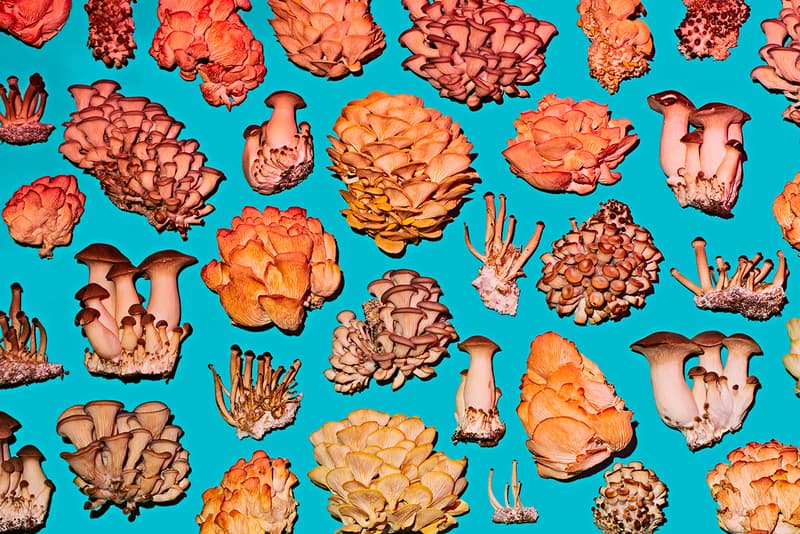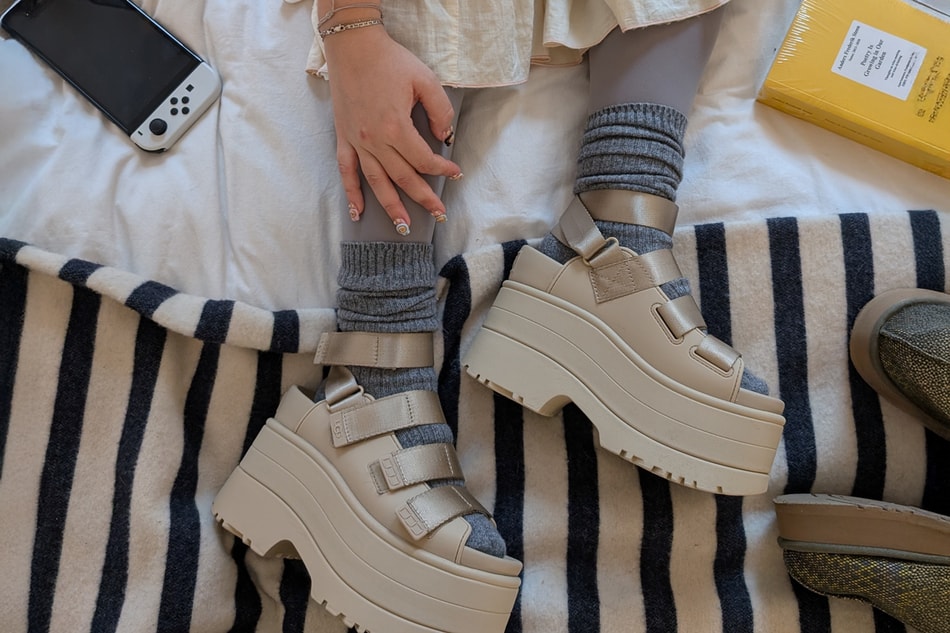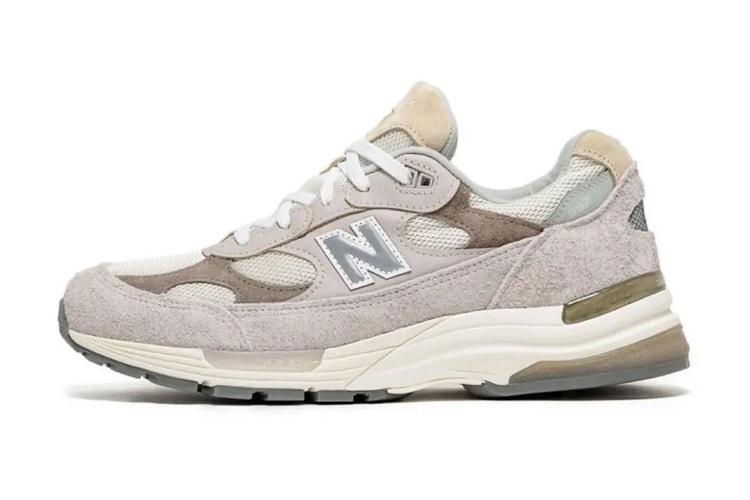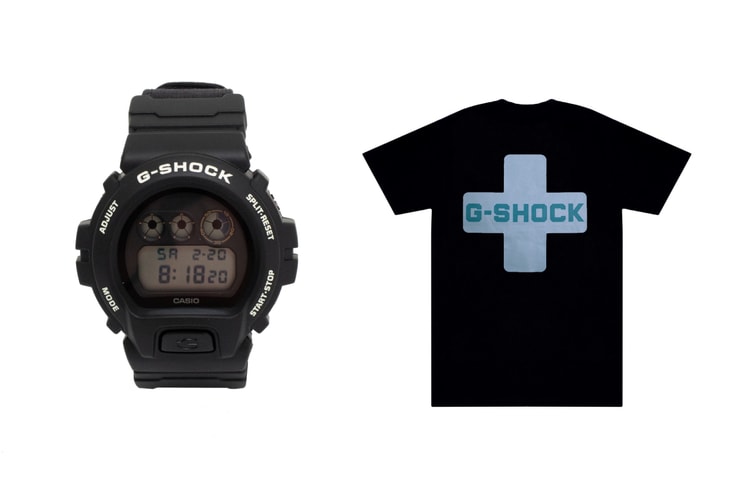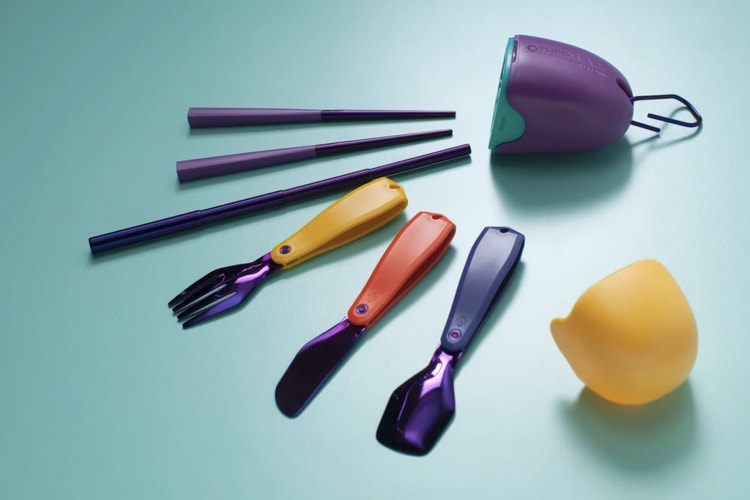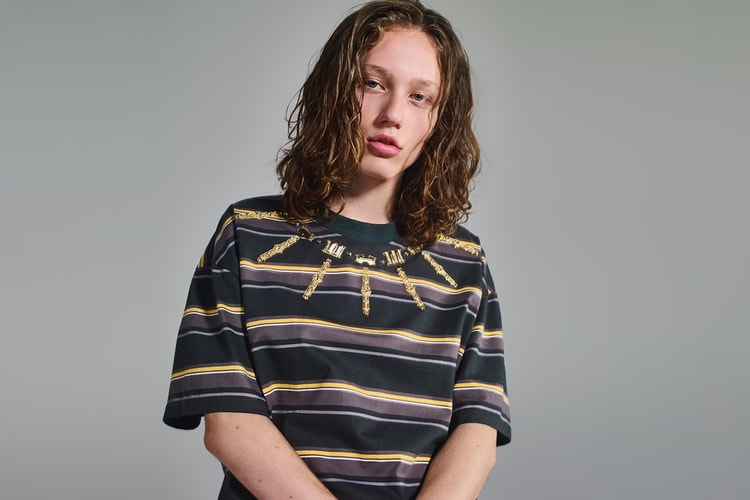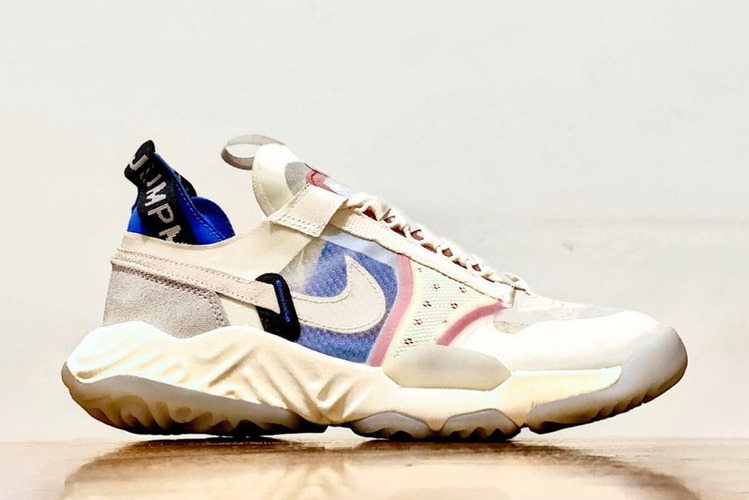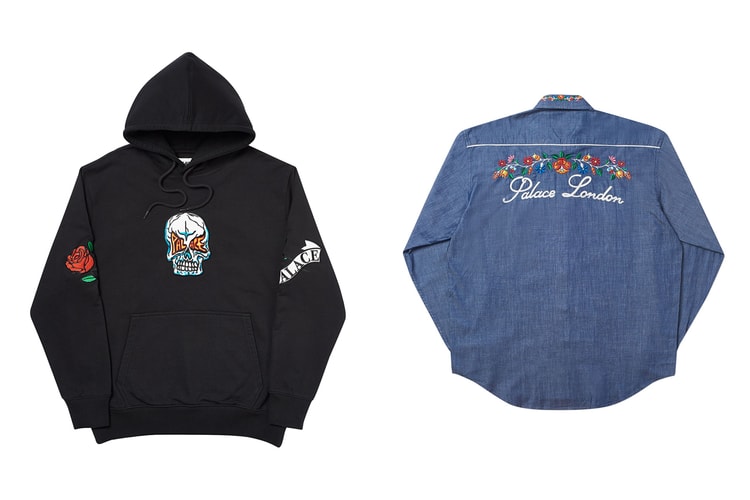Making Mushrooms More Than Edible
Brooklyn-based Smallhold is elevating the simple art of grow-at-home fungi into “sculptures that you eat.”
Mushrooms have started sprouting everywhere. Earlier this year, an exhibition at London’s Somerset House explored the power of “the remarkable mushroom, and all the progressive, poetic and psychedelic wonder it evokes,” with works from Takashi Murakami, Cy Twombly and more. Mushrooms are also an evocative symbol, which has become a frequent reference point for brands including Story MFG. and Online Ceramics.
That environment has allowed Smallhold to flourish. The Brooklyn-based mushroom producer was founded in 2017, and made its name installing “minifarms” inside restaurants, hotels and grocery stores across New York, including Whole Foods, The Standard Hotel and Mission Chinese. “Mushrooms were becoming cool,” explains Andrew Carter, who co-founded the company alongside his college roommate Adam DeMartino. “People were moving to vegetarian diets, a lot of people eat mushrooms and it’s only increasing in the U.S.”
New York’s stay in place orders as a result of the COVID-19 crisis forced Smallhold’s clients to close. As a result, Smallhold began selling home-grow mushroom kits to people across America, helping to fuel a surprising lockdown hobby. Originally, Carter and his co-founder Adam DeMartino wanted to shift extra stock and sell off the agricultural blocks they could no longer install. The blocks quickly found a receptive market in the homes of chefs, waiters and other service industry employees of Smallhold’s extended community. The trend grew through word of mouth — and Instagram posts — leading DeMartino and Carter to sell these blocks to a larger public.
“People expect more from their produce, they expect a story. Mushrooms tell a great story.”
The kits feature a large block, made mostly from sawdust with additional plant material that allows the mycelium to grow. Once you’ve bought a block, all you need is a spray bottle filled with water, a rubber band and a clean, sharp knife. Within seven to 10 days, the blocks will start producing mushrooms to be harvested. The attraction to the mushroom blocks is part functional — the kits can provide a consistent food source — and part aesthetic, with the ever-changing blocks becoming temporary home art installations.
Currently, Smallhold sells grow kits at $34 USD apiece for two varieties of mushroom — Lion’s Mane and Blue Oyster — while its subscription service, which goes for $120 USD for two months, also features two further types of Oyster (Yellow and Phoenix). Additionally, the company delivers fresh mushrooms across Brooklyn and Lower Manhattan, with Maitake and Chestnut also available.
HYPEBEAST recently caught up with DeMartino and Carter to discuss the company’s history, how to grow mushrooms at home and Smallhold’s plans to spread a mycelial network across the world.
HYPEBEAST: How did Smallhold get started?
Andrew Carter: Adam and I are old college friends. Adam has a lot of experience working with different start-ups and being at the ground level starting tech companies, and my background is in indoor agriculture, working on commercial greenhouses around the world.
I saw an opportunity to grow high-quality mushrooms in urban areas. We originally thought we could apply a lot of the technology used in greenhouses and hydroponic facilities to mushroom production. We quickly realized that mushrooms grow completely differently to other plants; they’re more like animals than plants. Not only did we reinvent a lot of this stuff, it only made us more excited about growing these kinds of things. It’s a refreshing look at agriculture.
When we started we realized that there was not only this opportunity to grow mushrooms but to change how distribution works in general. We developed some technology, developed a new supply chain and developed a way in which people can grow mushrooms inside restaurants and grocery stores. After COVID-19 we figured out how to offer fresh blocks for people to grow at home and we became a source for mushroom production throughout the U.S.
“It’s like having an ephemeral sculpture that you eat later. I love the concept of this piece of art that isn’t going to be there forever and every one is unique.”
Why did you choose mushrooms?
Carter: In general people were just very interested in mushroom production. Additionally, growing mushrooms is just a really amazing process. All the substrates we use are from waste strains, we are essentially part of a circular economy, most of our waste goes back to compost. It’s just a really great thing to grow.
Adam DeMartino: The biggest innovation in the mushroom category for the past 30 years has been slicing them, growing them bigger or smaller. It’s still mostly the same button mushroom, it has very little taste, it’s good maybe on a pizza sometimes. The reality of the situation is that there’s a whole kingdom of produce, so you can begin to explore that. People expect more from their produce, they expect a story, and mushrooms tell a great story. If you’re looking for a source of wholesome, nutritious goodness in a time when things are crazy, mushrooms can be that.
How did you start working with local restaurants?
Carter: We originally wanted to do this with farmers. The idea was that you could install one of our units, work with our supply chain and we can add a little extra income. But we’re in New York, and as soon as we started building this we started getting demand from all sorts of different customers. We saw the opportunity to work with some of these restaurants and to give them the opportunity to grow their own mushrooms. We find restaurants and grocery stores and partners all around the city to give us a little bit of space so we can grow their fresh mushrooms right there.
Originally we thought it would be a back-of-house situation, we were providing fresh produce and they can go and harvest it and serve it to their customers. Most of these restaurant owners wanted to show it off to their customers and we figured out really creative ways to do that. Some are right when you walk in the door, some are hanging above bars, we have all sorts of formats that were growing mushrooms in the city.
DeMartino: It was very much a product offering that was honed in conjunction with the creative chefs around us. That’s basically why we started selling the blocks in a way as well. It’s a similar process. We’re very clearly business folks, we take this seriously, but on the other side of things, we’re very in tune to New York City and the restaurant community, and they have just lost their jobs.
So that’s when you started selling the blocks for people to grow at home?
DeMartino: We started selling the blocks because we had extra, we didn’t think we would be able to sell more mushrooms because all the restaurants had been told to cease operations for a few weeks. What wound up happening was that there was a line of chefs who were keen to buy produce to cook at home, they started growing mushrooms at home. This is their world, these are the mushrooms they work with in the kitchen all day, now they take them home and they’re growing. They have time to sit and experience the whole process of mushroom growing.
Carter: The key thing with the blocks is that they are agricultural products. When you’re growing them at home it takes a lot of work — you’ve got to mist them throughout the day — but there’s a good chance that Oysters will pop out. Sometimes it doesn’t work out, that’s just how growing stuff works.
“People are really excited about these organisms as a food source and the sense of mystery behind them.”
Essentially after a week or two, people kept asking to buy our blocks to grow at home, so we began shipping substrate blocks to grow Oyster and Lion’s Mane throughout the country. People are being creative and figuring out ways to grow their own food, and mushrooms are an amazing way to do that. They grow so quickly, they’re so beautiful, they’re almost alien for a lot of people. Every time you wake up you see a new development.
DeMartino: At the beginning of the COVID-19 situation here in New York City a lot of people were worried about what was going to happen, especially in the restaurant industry. These blocks became sustenance for a few folks for a few weeks. Like Andrew said, they’re agricultural products. They’ve been genetically and scientifically honed and selected over generations here to produce lots and lots of mushrooms. In the beginning people were getting like five pounds of mushrooms off it. That’s a lot of food. It made us feel really good to feel like we were doing something that helped people in a time of crisis.
How did it spread from the community around you to across the country?
Carter: The word got out through friends of friends taking photos, telling each other, posting it on Instagram.
DeMartino: We take mushroom growth a little bit for granted as mushroom farmers, we’ve seen thousands and thousands of pounds of mushrooms grow off these blocks, it’s not a new thing for us. I’d lost sight of how incredible it is, but seeing people interact with them on Instagram or send us pictures made me see it in a new light.
Andrew has a theory about mushrooms, if somebody gets into mushrooms, they get really into mushrooms. For some reason it’s easier to fall into the wormhole of mushrooms than other things you might be interested in, they have so many facets to them. We’re also surrounded by so many artists and designers of all manner of backgrounds who all have their unique takes on it. I feel like that’s part of it. The content that’s been created with these mushrooms is just crazy.
You mentioned before that mushrooms look a bit alien. For a lot of people having that in their house is quite interesting.
Carter: It’s like having an ephemeral sculpture that you eat later. I love the concept of this piece of art that isn’t going to be there forever and every one is unique. It doesn’t matter if they all come from the same spore, because of your environment and because of the situation it’s given, it’s going to look completely different from the next one. It happens quickly, after you open this thing it’s growing within a week, then it takes about another week until you’re harvesting. Having something go from this lifeless block to having those beautiful mushrooms in two weeks, there’s nothing like it. I don’t know much else that grows like that.
The installations in restaurants have become a kind of sculpture as well, which is being replicated in people’s homes in a different way.
Carter: Putting blocks in other people’s homes is just another extension of our farm. The concept of Smallhold is distributing our facility, because we can’t build a huge warehouse in Brooklyn. We standardize parts of our supply chain, we centralize parts of our operation, but the rest of it is put in restaurants, grocery stores, warehouses, other people’s kitchens. This is just another way of getting the freshest mushrooms possible to people.
We’re also trying to tell a story of mushrooms. People are really excited about these organisms as a food source and the sense of mystery behind them. For someone to be able to wake up every day and look at it and experience it — whether that’s inside a restaurant or inside your apartment — it’s a connection to it that’s not really there if you’re going to the grocery store and buying one that’s been shipped across the country.
What are your plans for the future of Smallhold?
Carter: When we think of our company and what we do, we try to look at nature. We’re very ecologically-focused and we think we have a lot to learn from it. Shipping blocks not only to New York but to communities throughout the country is us spreading the word. It’s spreading a spore, like a mushroom would. It’s germinating in different areas and in people’s minds and by the time we are ready to go to their regions, they already know about us, they’re obsessed with mushrooms, they’ve been growing mushrooms in their apartment for quite some time. It allows us to continue to grow sort of like a mushroom would, and hopefully as fast as it would. We’ll be working with our community and working with all these people growing at home to grow in their cities all around the world.
DeMartino: The specialty mushroom category is very much a blue ocean category right now in the United States and the Western part of the globe. The more people growing mushrooms in whatever form, the better for us. It promotes the entire category. We don’t see people growing mushrooms at home or starting their own mushroom farms in their basement as a competitive thing. We do the opposite, we try and help introduce people to new sources to help them to do that. Ultimately it broadens the category for everyone, and the more people eating mushrooms the better.

